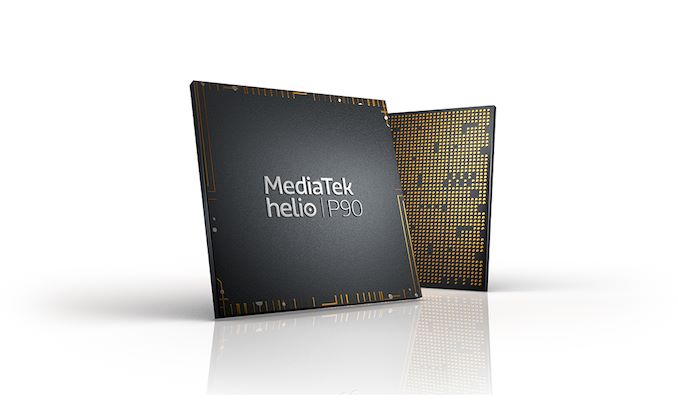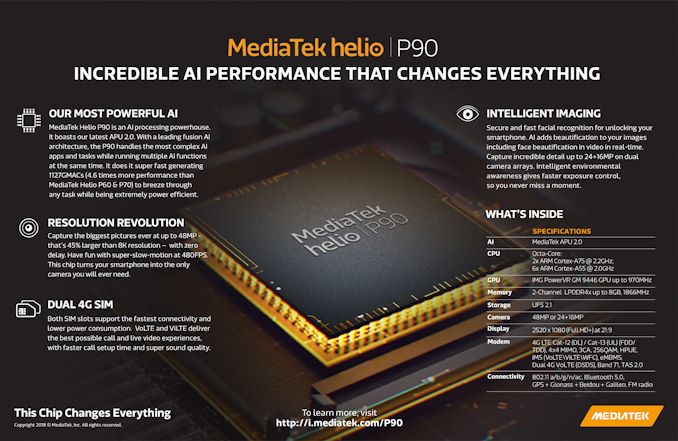MediaTek Announces New Premium Helio P90 SoC
by Andrei Frumusanu on December 13, 2018 5:30 AM EST- Posted in
- Smartphones
- Mobile
- SoCs
- MediaTek
- Helio P90

It’s been a while since we’ve talked about MediaTek – the Helio P60 was the last release in the more visible “premium” range that the company now focuses on. The P70 released later this year seemingly was the same P60 chipset binned at a higher clock-speed. With new generation manufacturing processes around the corner, as well as Arm’s new Cortex IP cores, I’ve been expecting a new release from MediaTek for a while now.
Today’s announcement is about the new Helio P90: The new chipset is quite a surprise as it isn’t exactly what I had expected. The P90 naming seemingly positions the chipset at the very high-end of the “P-series”, yet its specifications aren’t exactly matching this positioning.
Let’s start on the specifications of the P90:
| MediaTek Current P-Series | ||
| SoC | Helio P90 | Helio P60/P70 |
| CPU | 2x Cortex A75 @ 2.2GHz 6x Cortex A55 @ 2.0GHz |
4x Cortex A73 @ 2.0/2.1GHz 4x Cortex A53 @ 2.0GHz |
| GPU | PowerVR GM 9446 @ 970MHz | Mali G72MP3 @ 800/900MHz |
| APU / NPU / AI Proc. / Neural IP | 2x +140GMACs (Tensilica DSP) + In-house Inference Engine 1127GMACs total |
2x 140GMACs (Tensilica DSP) |
| Memory | 2x 16bit LPDDR4X @ 1866MHz |
1x 32bit LPDDR3 @ 933MHz 2x 16bit LPDDR4X @ 1800MHz |
| ISP/Camera | 1x 48MP or 2x 24+16MP | 1x 32MP or 2x 20+16MP |
| Encode/ Decode |
2160p? H.264 & HEVC | 2160p30 H.264 & HEVC |
| Integrated Modem | Category 12/13 DL = 600Mbps 3x20MHz CA, 256-QAM, 4x4 MIMO UL = 150Mbps 2x20MHz CA,64-QAM |
Category 7/13 DL = 300Mbps 3x20MHz CA, 64-QAM UL = 150Mbps 2x20MHz CA,64-QAM |
| Mfc. Process | 12FFC | 12FFC |
At the heart, the new P90 is now MediaTek’s first Arm DynamIQ CPU configured SoC. The Arm Cortex A73 and A53 cores of the P60 and P70 have been replaced by the newer generation Cortex A75 and Cortex A55 cores. The A75 cores are clocked in at 2.2GHz, while the A55 cores come at a similar 2.0GHz clock as its predecessors.
What is very surprising here for MediaTek is the core-count for each core type: MediaTek has moved on from a 4+4 configuration to a 2+6 configuration, mimicking Qualcomm’s Snapdragon 670 and 710 chips. In terms of multi-threaded performance this should represent a downgrade over the P60/70, even though the new A75 cores should represent a good boost over the A73 cores. MediaTek talks about including a “large L3” in the new chipset, however doesn’t disclose its exact size, neither talks about the L2 configurations of the CPU cores.
On the GPU side, we see a big shift for MediaTek as for the first time in a long time we see the company putting aside Arm Mali GPU in favour of Imaginations new PowerVR GM 9446 GPU running at up to 970 MHz. This is Imagination’s biggest 9XM configuration and comes with 2 USCs for a fillrate throughput of 8 pixels per clock as well as a total compute throughput of 128 FLOPS/clock. To put this into perspective, this is roughly over double the fillrate of the P60’s Mali G72MP3 GPU and represents either a 77% increase in FMADD throughput, or an 18% increase in FLOPS/clock depending on if you also count FADD units.
On the machine inferencing side, MediaTek makes a big jump in terms of computational performance: Here we still see continued use of Tensilica’s DSP in the P90, the unit that was able to also handle machine learning inferencing workloads on the P60 and P70. This unit continues to be used in the P90, but on top of this MediaTek now for the first time integrates a dedicated inference engine that was designed in-house. MediaTek doesn’t break the figure down, but says the total performance of the units total 1127 GMACs. In the more conventional counting methods, a MAC is equivalent to two OPS, so in other words the P90 should be able to deliver about 2.2TOPs. It’s to be noted that the new inferencing engine seems to be dedicated for FP16 operations as the INT8 performance of the SoC is quoted to having been increased by only 10-20% - meaning such operations are still relegated to the Tensilica IP.
In terms of bandwidth, MediaTek still remains quite conservative in this regard as the P90 continues to still only feature a 32-bit wide memory controller in the form 2x 16b LPDDR4X channels running at up to 1866MHz, resulting in a theoretical bandwidth of 14.92GB/s.
Connectivity wise, we integrated has seen an upgrade from Category 7 to Category 12, doubling downstream peak download speeds to up to 600Mbps with the help of new 256QAM and 4x4 MIMO.
Lastly, imaging pipelines as well as the ISP are said to have seen big upgrades as the new chipset now offers multi-frame noise reduction, now supports larger sensors up to 48MP in single-camera mode or 24+16MP in dual operation along with acceleration for dual-sensor depth sensing and new software stacks making use of the new inferencing hardware, improving features such as edge detection.
So overall the MediaTek P90 looks to be a healthy upgrade in all regards- however it’s still very much a conservative SoC. Here MediaTek still lags behind in terms of integrating the newest IPs such as Arm’s new Cortex A76 CPU for example. The SoC is also manufactured on TSMC’s 12FFC process node – which does represent a disadvantage to MediaTek’s direct competition that the P90 positions itself against: the Snapdragon 670, 710 and even the newer 675. Because MediaTek markets the P90 this high up the P-series, I have to wonder if that we’ll soon maybe see a return of an X-series SoC featuring the higher specifications for a 7nm chipset next year.
The Helio P90 is said to be available to partners and we’ll be seeing first commercial devices announces towards the end of Q1 2019.











17 Comments
View All Comments
Raqia - Monday, December 17, 2018 - link
Just as computers costs are separate from the licensed software that runs on it (and may often cost much more), the specialized compute elements that implement parts of Qualcomm's patented cellular interfaces (all of 3G and most of 4G) have separate implementation costs from the licensed interfaces themselves. The way Qualcomm assesses fees for using their cellular interfaces is actually a discount for most manufacturers besides Apple, and multiple players do indeed implement SoCs or modems for third party sale, like Marvell, Intel, Samsung, Mediatek, and Huawei, and you haven't proved that many of the dropouts were simply less efficient than the companies still standing today.These cellular interfaces are non trivial btw (far more complex than UI elements or software APIs) and they cost billions in R&D to develop and greatly advanced the state of the art in the industry; far bigger empires were built off of much less technical sophistication as in the case of Intel's x86 instruction set. There is also much more vibrant competition in the cellular phone market due to these licensing practices market when compared with bigger laptop / desktop CPU manufacturers where your choice is basically x86 and only between Intel or AMD (which falters and leaves just Intel once or twice a decade.)
Plumplum - Tuesday, December 18, 2018 - link
Condamnations are there, even in western countries.This simple argument is enough!
How can people denie the problem?
Your comparison is not the same at all.
First, You are free to use a different software.
For exemple, if you don't want to pay licence to Microsoft for Windows, you can use Linux.
In case of standard essential patents, you can't make a smartphone without them. You're (OEM) forced to pay Qualcomm...no choice.
Second, that's not the same company who sell the licence and the hardware.
About Windows, Microsoft sells it and Intel or AMD make the processor.
Third, Microsoft doesn't use his licence to force you to buy one unique hardware.
Qualcomm refuse to sell his licences to competitors. Sell them directly to OEM...they can sell their licences with high price. Make a lot of benefits. And reduce the price of the soc to kick out competitors.
I only have some numbers from 2016.
Licence cost 1.1billions dollars and generate 7.6billions dollars revenu.
That makes 6.5billions dollars benefits.
Soc generate only 1.8billions dollars benefits for 15.4billions revenu
In 2016, marging on patents were 600%.
Marging on soc...15%.
80% of the whole benefits was made with patents. Only 20% with products.
I'm not saying, there is no problem with Microsoft. But these situation is different and far more dangerous.
levizx - Sunday, December 30, 2018 - link
You need spell checkerlevizx - Sunday, December 30, 2018 - link
Corepilot is nothing new, they don't customise ANY hardware parts so it could only be software scheduler, and it DOESN'T work well at all, considering MTK have to shutdown cores more often than their competitorsMTK did NOT "developpes" dual camera before Huawei, P9 had already launched actual Dual Camera when the first Helio X20 phone hit the market - with SINGLE camera setup. MTK's dual camera software wasn't ready in 2016, but Huawei's was. So Huawei developed dual camera BEFORE MTK.
MTK's first H265 enabled phone launched mid-2014, Qualcomm's launched Q3'14, only a couple of months later, and with 4K/UHD support, they were announced around the same time as well.
MTK's P60 is their first heterogeneous AI engine launched in 2018, while Qualcomm enabled 835/660 launched in 2017 with heterogeneous AI engine at the same time.
MTK first demonstrated dual VoLTE mid-2017, AFTER Qualcomm's demo with SDM835, and Qualcomm enabled dual VoLTE for SDM660/835 late 2017 with Oppo updated their phone on 6/Jan/2018 to enable dual VoLTE, in the mean time, NO MTK phone with dual VoLTE launched until months later.
So out of ALL the claims, ONLY 1 was true, MTK did support VP9 ahead of Qualcomm, that's all.
Plumplum - Sunday, December 30, 2018 - link
Sorry, spell checker is set on an other langage.Corepilot 3.0 allows tri-cluster, traditionnal big.LITTLE can't. It shows that hardware is obviously involved. It's customised design, so you're wrong.
Have you ever seen it working. Medias spread heating problem, but did they do any test?
810, 808 or even 652 shutdown far far more often!
My own shows only 6% perfs drop (Vernee Apollo Lite)
You can find a french youtuber compare X25 and SD652...SD was crushed!
Mediatek demontrated dual camera in february 2016 (at MWC)...P9 was released in April.
ImagIQ is able of both dual Color+Black&White (like P9) and dual multifocal (like Apple).
But Mediatek doesn't release commercial phone, it takes more time...(and sometime it's badly done by OEM).
They demonstrated first with prototype, but real phones comes later...so it depends if you consider working soc or working phone.
Mid-2014, mt6595 allows both 4k h265 decoding/encoding...SD805 allows only decoding, 4k recording use H264 codec, not hevc!
Mediatek demontrated AI on Helio X20 in february 2016 (MWC). Qualcomm presented their version a few monthes later...Snapdragon 820 allows heterogeneous multiprocessing.
Mediatek shows Dual-core...on entry-level mt6739 in september 2017 (India Mobile Congress)
But true, phones were released later.
I'm not wrong, but Mediatek has problem to sell, delays between availability of soc ans availability of devices.
I Hope it will change next year
oRAirwolf - Thursday, December 13, 2018 - link
The powervr GPU is intriguing. Does anybody know what the total single precision GFLOPs will be?Andrei Frumusanu - Thursday, December 13, 2018 - link
124GFLOPs.